REBECCA RENNIE BIG BOARD: SMALL SCHOOL 150
By Rebecca Rennie
As with every draft class, there is exceptional talent to be found outside the FBS. This presents my Top 150 of those small school prospects. Whether used pre-draft or after your team has picked up one or more of these players during or after the draft, I hope this provides some useful information or reference.
The first five pages provide profiles on the Top 50 small school prospects. Page 6 contains brief notes on the next 25. The final page contains the full Top 150 Big Board as a list.
There are a lot of players on this big board, many of whom will appear lower down on the list. I fully believe though, that with the right opportunity, every player included has the potential to be a successful pro.
In fact, there are countless other prospects that I know I will have missed. Unfortunately, this was a one-person operation without a full scouting team to hand. I’ve tried to get to as many players as possible, but had to get this posted eventually.
All draft boards are subjective and will have it’s share of misses along with hits. That’s part of the fun though, it would be dull if everyone was working off an identical board! Thanks for taking the time to look and enjoy the 2020 NFL Draft.
1. Adam Trautman, TE, Dayton. Grade: 2nd-3rd Round
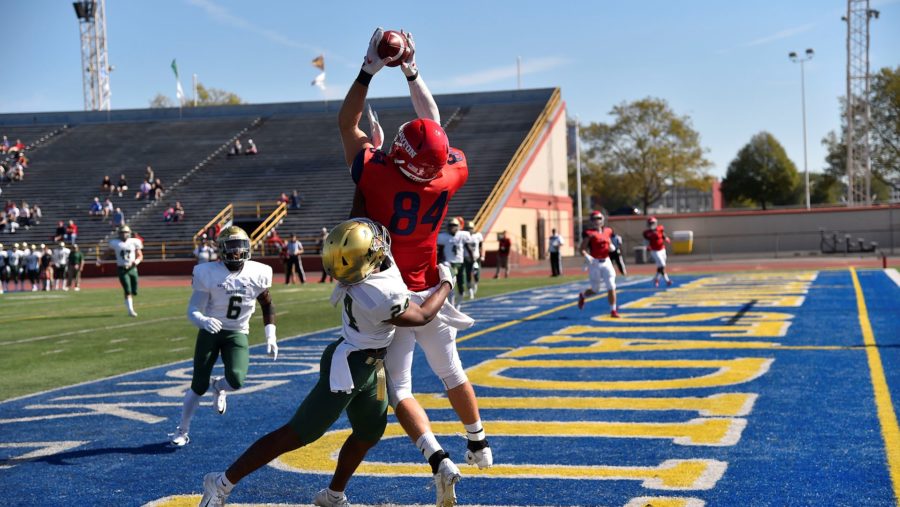
Height: 6’5”. Weight: 255lbs.
Pros: Featuring an ideal frame and appealing combination of size, strength and solid athleticism, Trautman looks the part. He ticks off plenty boxes in terms of measurables. While he didn’t run a blazing dash time at the Combine, Trautman is an efficient mover. The Flyers prospect has more than enough upfield burst off the line with quickness over short areas and long speed to stretch the field.
An ascending prospect, Trautman shows some rawness but improved over his time in college. He finished with his most productive season as a Senior (70 receptions for 916 yards and 14 touchdowns). Able to offer a complete game at the position, Trautman moves around the formation from inline and the backfield, to the slot and out wide. As a receiver, Trautman is most impressive at the catch point, consistently winning in jump ball situations. Using his catch radius and big frame advantageously, he positions himself well, high pointing with timing and a fantastic vertical leap.
His effort and aggression as a blocker are clearly evident. While doing so against overmatched competition, his dominance to drive defenders out of frame makes that difference more pronounced. Competition level wasn’t the best, but his Senior Bowl exploits eased concerns.
Cons: While he impresses in all facets of playing the position, there is some rawness in technique and overall execution. That isn’t a big surprise given the position switch from QB earlier in his playing days. Dominating in the Pioneer League is one thing, and there’s a chance that he takes some time to adjust to the significant step up in competition. That said, evidence presented at the Senior Bowl suggests he should do fine. Route running is a key area requiring refinement.
Trautman was able to separate comfortably in the FCS through his athletic prowess. There is some footwork inefficiency and wasted motion as he breaks many of his routes. He is also a little green in his spacial awareness, including working through traffic over the middle of the field. It should be noted though, that Trautman never seemed to coast on his physical advantages over those he took the field with over his college career.
Wrapping Up: A convert to the position from quarterback, Trautman is still progressing as a tight end. The effectiveness shown as both a receiver and blocker despite being a work-in progress is encouraging, with exciting upside. With his frame, smooth athleticism and traits, he deserves to be in consideration for the best tight end in the 2020 class. NFL Comparison: Dallas Goedert.
2. Ben Bartch, IOL/OT, St John’s (MN). Grade: 3rd Round
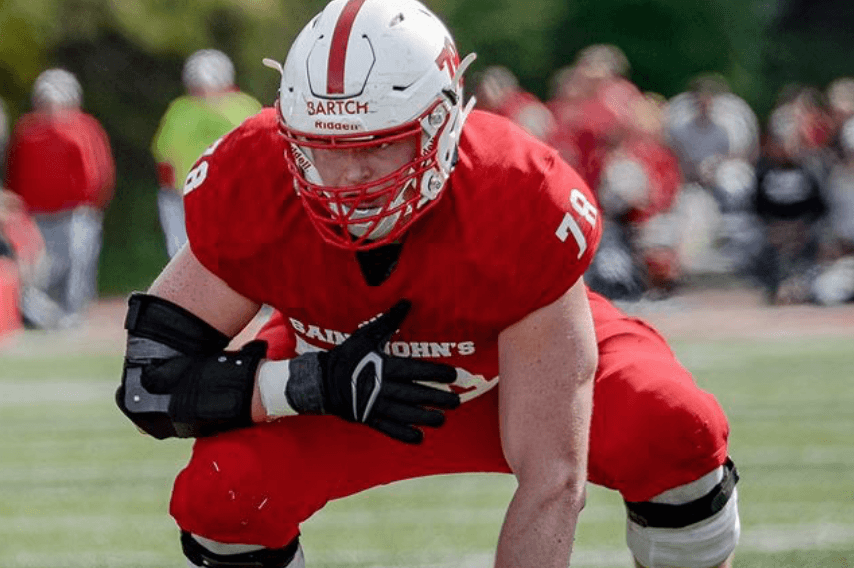
Height: 6’6”. Weight: 309lbs.
Pros: The Division III prospect inevitably dominates on game film. There was therefore an element of the unknown as to how he’d hold up at Senior Bowl week. No need to worry however, as he not only survived, but thrived, winning the majority of his 1-on-1s. The converted tight end has done an incredible job of piling on good weight to his frame.
Bartch has good initial pop out of his stance and a quick first step. He backs that up with aggressiveness at the point of attack. His hands are quickly on the attack with an early punch. While he’s likely to move inside, as a left tackle in college Bartch got good depth in his pass sets, utilizing his long strides. Footwork, coordination and balance are all pluses in his game.
Bartch demonstrates good recognition and overall football IQ to identify and handle pressure and late blitzes. An appealing balance of brain and brawn, his smart play is joined by a propensity to deliver some nasty finishes to his blocks in both pass protection and as a run blocker.
Cons: While there’s potential to offer versatility both inside and outside, Bartch’s arms measured in at below the common threshold of 33”. A move to the inside seems more likely but could still provide tackle depth and has the potential to excel at guard. His relative inexperience and playing at a lower level are obvious cons to list. The Senior Bowl was encouraging but some early transitional struggles wouldn’t surprise.
While Bartch’s quick hands are a positive, his placement is one of his biggest technical issues, limiting the impact of his punch. His frame could still use additional bulk, despite what he’s added to this point. Though he has good movement to make plays in the run game in space, accurately executing those blocks can be hit and miss, literally, at this time.
Wrapping Up: While there’s a steep learning curve to the NFL from DIII, Bartch has physical and mental traits to work with, and the potential to start as a rookie. At the same time, he could use further development of his frame to fully unlock his ceiling. There are technical flaws to correct but has the mental approach to take to the coaching required. NFL Comparison: Mitch Morse.
3. Jeremy Chinn, S, Southern Illinois. Grade: 3rd Round
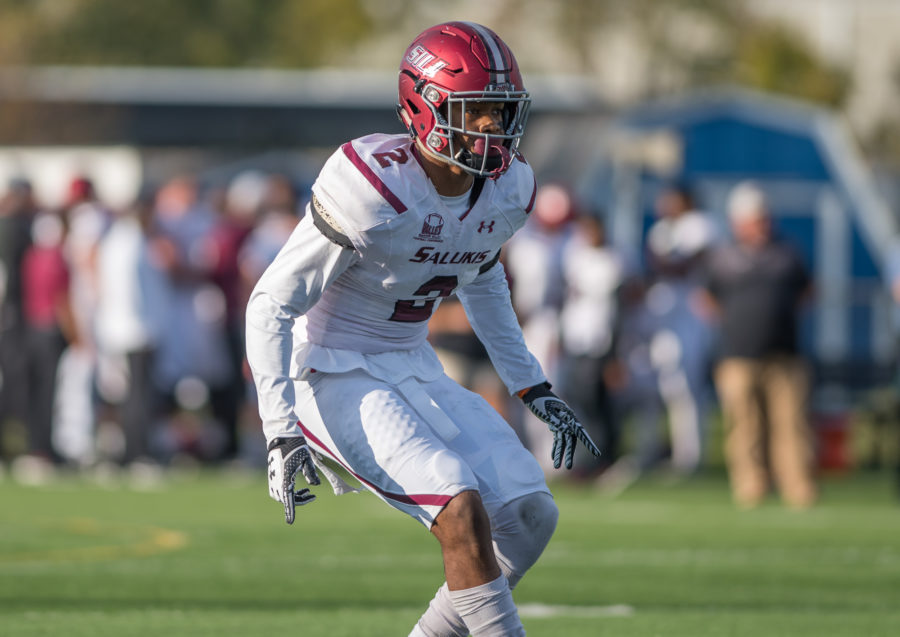
Height: 6’3”. Weight: 221lbs.
Pros: Chinn features a rare combination of measurables with elite size and athleticism. His long and physical frame is complimented by his exceptional Combine testing numbers. The Salukis safety ran 4.40 (1.53 10-yard split) in the dash, jumping 41” vertically and 11-6 in the broad. He added 20 reps on the bench.
Chinn has an imposing presence on the field as a dominant tackler. In addition to hitting with force, he uses his length to wrap up fairly and reliably. What consistently stood out in Chinn’s film was his ability to break down in space and make tackles in the open field. Chinn works well off contact when navigating through bodies and blocks, with good hand use when creating his path to the ball carrier. There are issues in the early phases of coverage, but at the catch point Chinn is combative in fighting for position. Regularly making plays on the ball, his ability to high point shows up often. The Southern Illinois standout has 13 career interceptions, including at least 3 each season.
Chinn is often critiqued for his recognition and reads, however, there’s arguably plenty of positive examples in those areas on film. Trusting his reads, many of his quick decisions have positioned himself for a number of his highlight interceptions. There’s flashes of keen eyes, patience and disciplined positioning.
Cons: Chinn has some exceptional highlights but on a snap-to-snap basis, he can be quite inconsistent. Between some of the thumping hits in run support are examples of flowing downhill with inefficient angles and taking himself out of the play, over-running the action. Getting caught up in traffic can result in being late to the ball carrier. As athletic as Chinn is, some lethargic looking plays at times are present.
In coverage, Chinn impresses as the ball arrives but has his moments of losing his positioning and losing track of the football. Some disappointing footwork and late reactions in coverage situations can affect his impact on some pass plays. There are no significant holes in any area of Chinn’s play, he’s proven he can be a factor in all roles of playing the position. Doing so more consistently though will allow him to hit his unquestionably high ceiling.
Wrapping Up: It’s been a gradual process getting to this point with Chinn, at least in terms of the personal evaluation here. The physical and athletic profile is the equal of any defensive back in this class, if not any class. He’s far from a clean prospect. Despite the athletic testing, he doesn’t always appear as dynamic on film as he can be, with some modest footwork and short area quickness at times. The coverage skills are very inconsistent. His downhill work can include some poor angles and over-running the action.
While the film could be more consistent, there’s a relatively safe and high floor to Chinn’s projection. Chinn is worthy of being valued as one of the better small school prospects in 2020. While this is an individual evaluation, it’s noted that he has a more comfortable projection to the NFL that his small school safety classmate Kyle Dugger. NFL Comparison: Clayton Geathers.
4. Kyle Dugger, S, Lenoir-Rhyne. Grade: 3rd Round
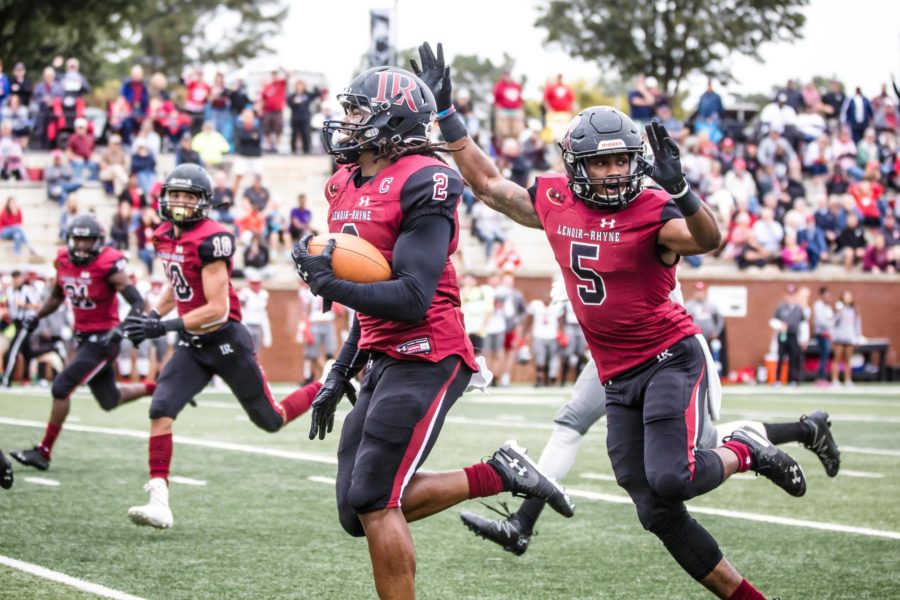
Height: 6’1”. Weight: 217lbs.
Pros: The physical traits and resulting ceiling/upside are the primary reason behind the meteoric rise in draft stock for Dugger. The full compliment of measurables reflect that intrigue. Dugger came in at a stout build with long arms, wingspan and huge hands. His Combine included a 4.49 dash (1.51 10-yard split), 42” vertical and 11-2 broad jump. There were the occasional flashes at the Senior Bowl that demonstrated what he could potentially do on a more consistent basis with his range and physicality. It was far from a stellar week at the Senior Bowl overall, but showing hints of the upside against better competition than on his Division 2 film was necessary.
With debates as to his best fit on defense, Dugger could have a fluid hybrid role that incorporates elements of playing both safety and linebacker. He has the potential to show up regularly in space and in the box. While his film is hit-and-miss, the straight-line speed is obvious, closing in a flash, with excellent recovery speed as required. When the opportunity is there to make an impactful hit, he takes it emphatically.
Cons: While a lot of players reveal more of their positives with more viewing of film over time, Dugger has been the opposite. Frankly, the more film watched of Dugger, the more concerning it becomes, with increasing doubt over his projection. The film is very rough. While he’s physically a step above everyone he’s on the field with, much of the play is underwhelming even at that level.
His athleticism often bails him out in a way it won’t at the next level. The anticipation and reads are highly inconsistent, as is his positioning, angles and regular late reactions. There’s no doubt that he has the chance to improve in all aspects with a higher level of coaching he’ll receive in the pros. However, there’s just as big a chance that he fails to make the step up to the pro level.
Dugger struggles in much of the nuances in coverage and could prove a liability in this area with questionable instincts. As fantastic as the overall athleticism unquestionably is, he does appear a little tight hipped working backward and in some of his redirecting. Turning 24 years old prior to the draft, the 6th-year senior is a little older than ideal. Added to his potential to require time to transition to the higher level of competition, it may put some teams off a little.
Wrapping Up: Initially quite excited regarding Dugger, his evaluation has cooled a little bit here with further analysis and film viewing, including returning to the Senior Bowl practices and game. He is a significant project and highly raw. The film is very rough with frequent absences of positioning, situational awareness and late reactions. The athleticism, range, impact tackling and overall upside are certainly tempting. Making that investment in the first couple of rounds comes with a significant amount of risk, however. NFL Comparison: Calvin Pryor.
5. Reid Harrison-Ducros, CB, Duquesne. Grade: 4th Round
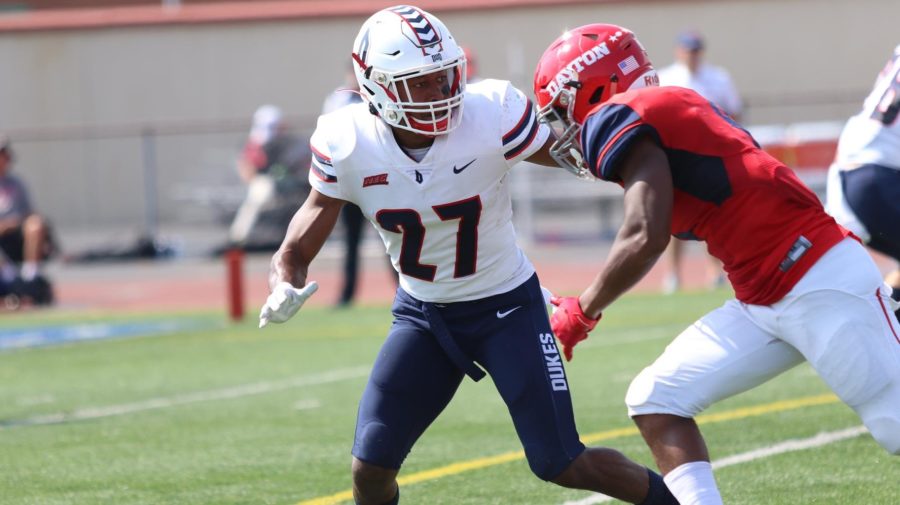
Height: 5’10”. Weight: 183lbs.
Pros: Though not the biggest, the Boise State transfer brings the athletic traits to compensate. It’s unfortunate that he can’t put out more official pro day testing numbers, but his personal workouts have shown elite short-area quickness and agility. Harrison-Ducros offers plus footspeed, burst, lateral and backward agility.
The other element to the corner’s game that stands out is his exceptional positional IQ and instincts. That combines with technique much more nuanced than many small school prospects. He demonstrates great feel, anticipation and situational awareness that aids him in man coverage assignments. His resulting abilities to keep tightly in-phase running in man coverage and stay sticky at the top of routes is clear on film. Harrison-Ducros rarely gives up separation on route breaks but shows impressive click-and-close and recovery speed when called upon. He backs up his technique and instincts by proving highly combative, playing big and rising to physical challenges.
Harrison-Ducros trusts his reads and picks his moments to jump routes and attack the football in the air. He brings the right level of aggression without venturing into reckless. His nice vertical and timing compensate for lack of size when challenging at the catch point. The playmaker’s four INTs this season is reflective of his overall good ball skills. While he lacks length, the Duquesne DB shows effort and physicality to contribute solidly in the run game.
Cons: The size brings some limitations and potential to not hit thresholds for some teams and systems, even though his athleticism negates most of those questions. It likely limits Harrison-Ducros to a slot role, though that role has arguably never been of a higher value than now in the pros. After starting the first 4 games of his sophomore season at Boise State, Harrison-Ducros played only sparingly after, in part initially due to injury. That led to his transfer to Duquesne in search for more consistent playing time.
There’s no doubt that the Dukes corner is a fantastic athlete with a strong football IQ, but there are a couple occasions on film where he’s left trailing receivers early in routes. These may just be minor moments of dropped concentration and he certainly has the recovery speed to rectify those situations.
Wrapping Up: A fantastic combination of twitched-up, tenacious and technical, Harrison-Ducros has a lot to like in his skill set and play style to translate well to the next level. His size and small-school status are factors to consider but he is one of the more exciting under-the-radar FCS prospects. He shows a lot of the same positive traits at a similar size to his NFL comp listed below that has worked out very well for the Ravens when healthy. NFL Comparison: Tavon Young.
6. Isaiah Coulter, WR, Rhode Island. Grade: 4th-5th Round
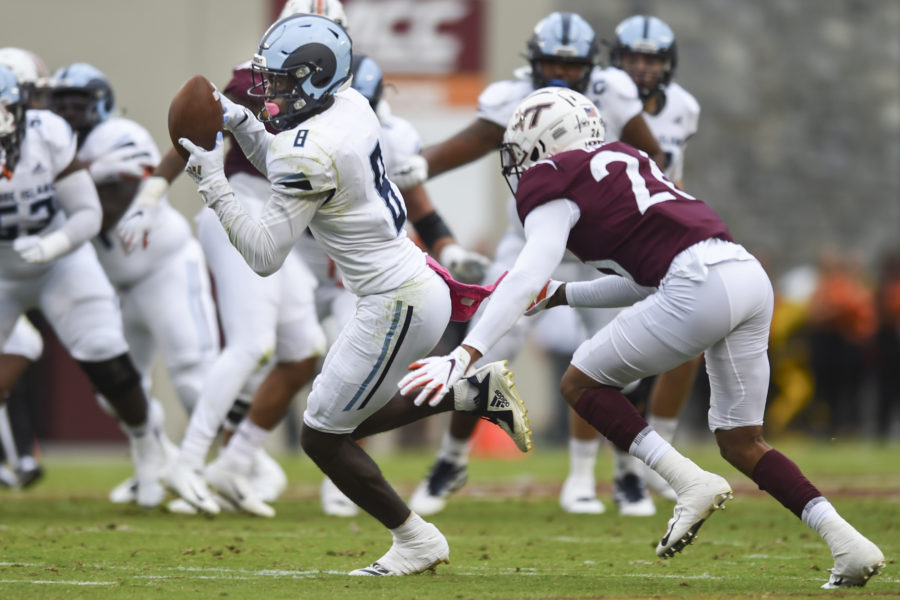
Height: 6’2”. Weight: 198lbs.
Pros: A relative surprise to declare early for the draft, but the potential evident in his film saw him extended a Combine invite. He had up-and-down testing but showcased straight-line speed with a 4.45 dash time. Coulter improved his production and impact each of his three seasons in college, showing continued progression as an ascending player. The Rams receiver excelled in his biggest showcase opportunity against Virginia Tech in 2019. He totalled 9 receptions for 152 yards against the Hokies.
Coulter features a lean but toned frame with smooth all-round athleticism. Coulter’s film stands out for his consistent smart play, recognition, awareness and feel for space. He routinely takes advantage of open zones offered by the defense. His savvy play extends to taking on man coverage, positioning himself favorably relative to defensive backs.
His ability across a variety of routes includes execution of digs, outs, slants, crossers, comebacks among others. He uses his hands well both in the initial phase of routes versus press and down the field when fighting for position against close coverage. Displaying strong hands, Coulter consistently makes plays outside his frame, including off-target throws, with good concentration in traffic.
Cons: While he proved his straight-line speed in his testing, Coulter doesn’t separate consistently on film. His route running could sharpen with some rounded route breaks and not always utilizing his burst to maintain speed as he redirects. His short-area quickness and overall change of direction skills are brought into question with his 7.28 time in the 3-cone drill at the Combine, one of the poorer results among wide receivers at the event.
Wrapping Up: Instinctive and natural, Coulter has a great feel for the position. He offers inside-outside versatility, great positional and field awareness and no glaring holes in his game. Given that there is still some inconsistency and some lax execution, there’s likely further untapped potential to unlock. That gives Coulter upside to outplay his ultimate draft position. NFL Comparison: Rashard Higgins.
7. Auzoyah Alufohai, DL, West Georgia. Grade: 5th Round
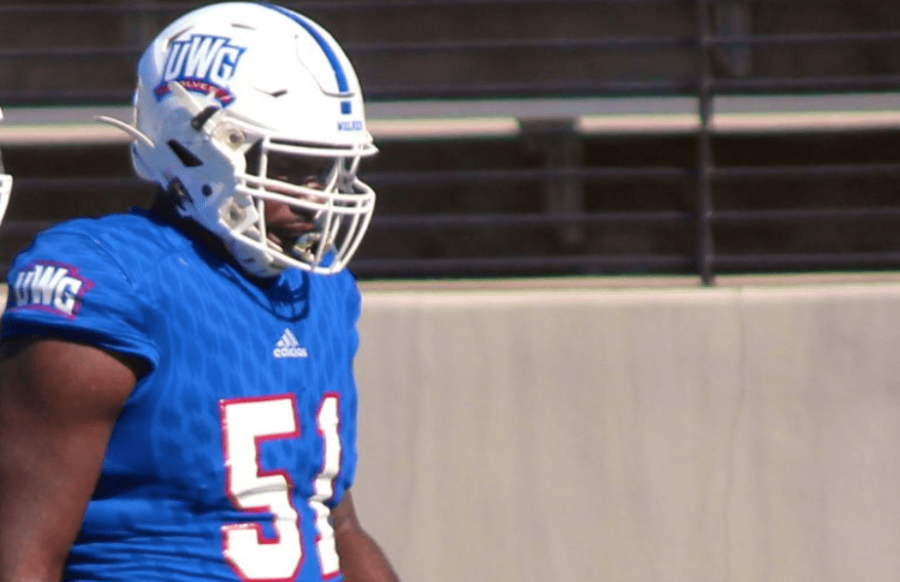
Height: 6’4”. Weight: 313lbs.
Pros: Much of the D2 film of Alufohai is almost unfair in terms of the difference between he and his opposition. The Kennesaw State transfer is capable of dominating outmatched opponents. Alufohai has legitimate NFL size and core power to find a role at the pro level. In addition to flashing that dominance at both the FCS and D2 levels, he proved he can impose himself against better competition, impressing at the East-West Shrine event. All reports from Shrine Week indicate that Alufohai proved he belonged, displaying his outstanding strength.
While there’s work to be done to refine his game, the small school standout has shown he can overcome challenging situations. Injuries and an unfortunate situation regarding his academics resulted in where he played and his need to transfer for his final season. All indications point towards having a high character and as a resilient person.
Alufohai offers a monstrous frame with width and length in his arms (over 34”). He is able to disrupt with his bull rush, jolt linemen backward, breaking pocket integrity. He can bully his way into position to make run stops and draw double team attention. Though he could show it more often, Alufohai flashes nice hand use. More than just a power player, Alufohai shows he can disengage and execute some effective clubs and swipes, push-pull and swim moves. The powerful D-lineman moves well for his size, with solid reactions off the snap and shows some quickness and change of direction.
Cons: While he regularly dominated on film and showed out at Shrine practices, he remains relatively unproven against better opposition. Though the traits on offer matter much more, the statistical production has been good but not outstanding. In 2019, Alufohai has solid totals of 31 tackles, 4 TFLs, 2 sacks and 3 forced fumbles.
The highlights are enticing, but there’s certainly some technical refinement required. That isn’t surprising given his late start to the sport and playing only 1 season in high school. There are some technical flaws and inconsistencies to clean up. He can get over his pads a little too much and lower his head to the turf as he engages. He doesn’t always make full use of his physical advantages in terms of playing with consistent pad level and extending his long arms.
Wrapping Up: A late starter, Alufohai only played one year in high school before playing at a pair of smaller schools. The untapped developmental potential is therefore exciting for a prospect who clearly has NFL level size, length and power to offer. Able to dominate at the point of attack, Alufohai can destroy running lanes and be a disruptive force in the middle of the defensive line. There’s starting upside with this under-the-radar small school prospect. NFL Comparison: Folorunso Fatukasi.
8. Mason Kinsey, WR, Berry. Grade: 5th Round
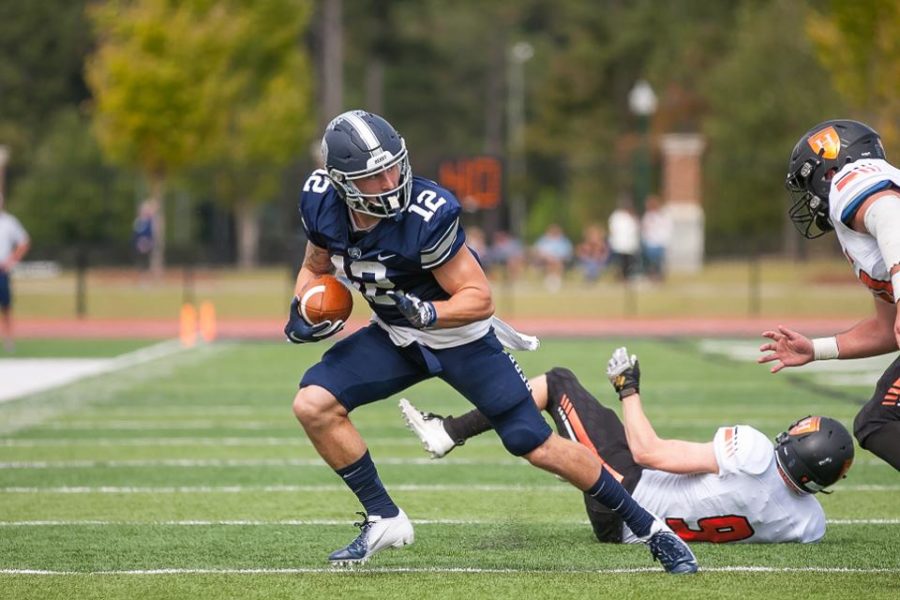
Height: 5’10”. Weight: 198lbs.
Pros: It’s a shame that Kinsey didn’t receive a Combine invite. It seemed he’d done enough to earn a spot after an outstanding showing at the East-West Shrine week. Kinsey was reported to be practically uncoverable during the 1-on-1 drills and impressing with his polished route running and quickness. Those traits show up on film too, despite the obvious disparity in quality of opposition, playing at the D3 level. Kinsey shows off burst in his releases, efficiency in his route breaks and minimal wasted motion.
He’s able to gain consistent separation through his combination of short area quickness and sharp route execution. While he competed at a lower level, those traits should translate well to the NFL level, with the Shrine performances backing up that assertion. His polished game features varied speed during his routes and breaks, working of DBs with subtle feints, double moves and maintaining speed as he redirects. His versatility and ability to create both underneath and over the top keeps covering defenders guessing.
Sure-handed, Kinsey makes plays within his catch radius, with a wider target window than many at his size due to good arm length at his height. Playing big, he is competitive at the catch point with excellent concentration under tight coverage. That physicality extends to his aggressive blocking; there’s a lot to love about his play style and overall demeanor on the field. With experience as a returner, there’s potential to offer a role on special teams as well.
Cons: There’s not a great deal with which to critique Kinsey’s game. His competition level in Division III is an obvious concern with a significant step-up in competition. The Shrine event gave him a chance to ease that concern by showing out against better talent but can only do so much. Taking some time to adjust to the NFL level would be understandable. Outside of that, it’s difficult to find fault. He’s not the biggest but is physical, strong and fast to compensate.
Wrapping Up: One of the more well-rounded and technically adept receivers in this class, he’s a big personal favorite. He may not have been invited to the Combine but still has a good chance to get drafted with his impressive skill set and high football IQ. He’s athletic, smart, works hard on his craft and shows outstanding technique throughout his game. NFL Comparison: Hunter Renfrow.
9. Kyle Murphy, IOL, Rhode Island. Grade: 5th Round
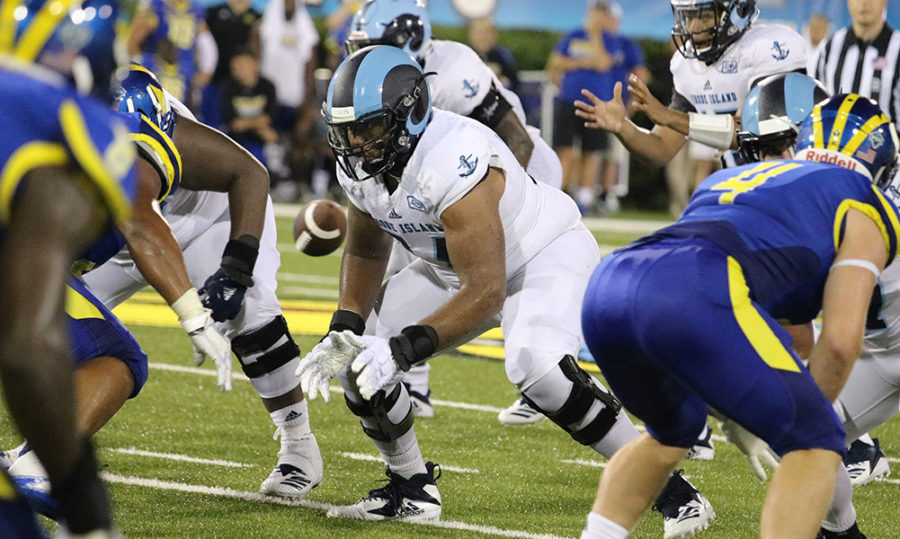
Height: 6’3”. Weight: 316lbs.
Pros: Has started at tackle, guard and center in college, with the potential to offer versatility at multiple spots. His 6’3” height might seem prohibitive to offering depth at tackle, but his arms are close to 34”. Murphy shows outstanding balance, body control and leverage as a pass protector. His pad level, length and coordination are impressive, as is his consistency over the course of games.
While he plays at a lower competition level, Murphy performed well in a key matchup with Virginia Tech in 2019. His play at tackle featured smooth athleticism to ride pass rushers round and behind the play. That movement results in some impressive plays upfield in the run game, seeking out blocks on the second level. He often destroyed defenders, finishing them emphatically to the turf.
Cons: Murphy has solid power, particularly for the FCS level. However, his anchor came under question at times at the East-West Shrine event. He flashes imposing, nasty play in the run game, but could do so more consistently. Hand placement is decent but is off target more often than ideal. In addition to having to make a step up in competition, switching back to the interior and against more powerful pro defensive tackles could be a challenge early. He could take a little time before being ready to start.
Wrapping Up: Murphy does not get a lot of attention, even among the small school prospects. He’s very worthy of his place among the few FCS prospects who received a Combine invite. His balance and coordination in pass pro are up there with the best in this class, regardless of level. He has length, moves well and plays with a calm and composed demeanor. It might take a season or two, but he could be looked back upon as a shrewd draft pick by the team who selects him on Day 3. NFL Comparison: Forrest Lamp.
10. RonDell Carter, EDGE, James Madison. Grade: 6th Round
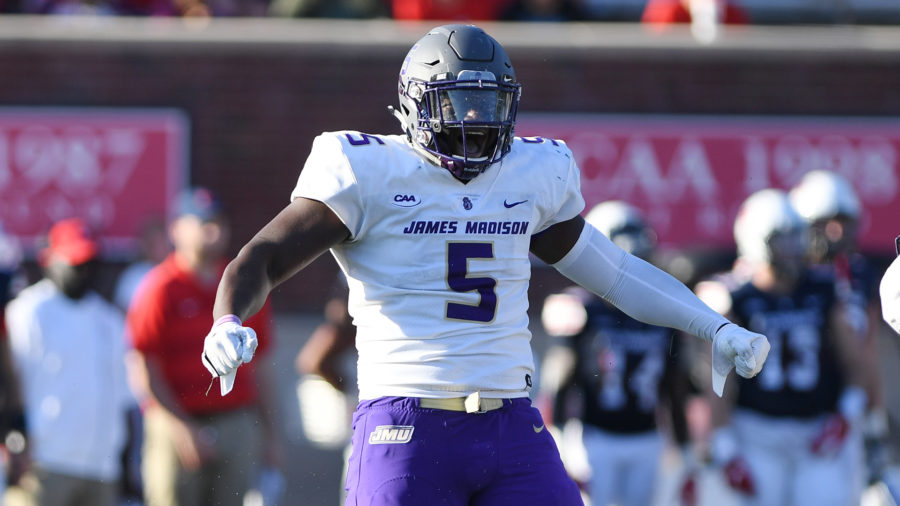
Height: 6’3”. Weight: 265lbs.
Pros: The Rutgers transfer put up a monster senior season. Carter piled up 66 tackles with a massive 27 TFLs, 12 sacks and a further 13 QB hurries. With consistent pressure beyond even those numbers, he was a disruptive force all year long. The senior wins with quickness and explosion that results in a highly active and disruptive game. The combination of a non-stop motor and lightning fast hands results in some instantaneous beats of offensive lineman. Whether executing a blur of a swim move or using his good reach and leverage to take control at the point, Carter needs to be accounted for every snap.
There ought to be some inside-outside versatility to make use of his speed and power from the interior on passing downs as well as off the edge. Despite Carter’s high-energy style, there’s plenty flashes of discipline setting the edge in the run game, timing his disengagements, and to force the action inside into the arms of teammates. With 33.5” arms and nearly 81” wingspan, has good length as part of a powerful, compact frame.
Cons: In truth, it’s difficult to find flaws in Carter’s game, with traits that ought to translate well. The transfer from Rutgers will lead to some questions on what didn’t go to plan with the Scarlett Knights. Prior to his transfer, Carter was not listed on the two-deep to begin Spring camp. There were suggestions at the time though that some changes to the scheme and assignments were not going to suit Carter’s skill set well.
Wrapping Up: It’s surprising that there hasn’t been more buzz around Carter during the pre-draft process. His lack of invite to the Senior Bowl, Shrine Bowl or Combine isn’t an ideal sign, instead attending the NFLPA Collegiate Bowl. Don’t be surprised to hear his name called on Day 3 regardless. Carter dominated the lesser competition and brings NFL level burst, power, aggression, balance and motor. NFL Comparison: Tyquan Lewis.
CLICK THE LINKS BELOW TO NAVIGATE THE REST OF THE SMALL SCHOOL BIG BOARD!
PAGE 7: Top 150 Full Big Board
Feature Image Credit: Dayton Athletics

